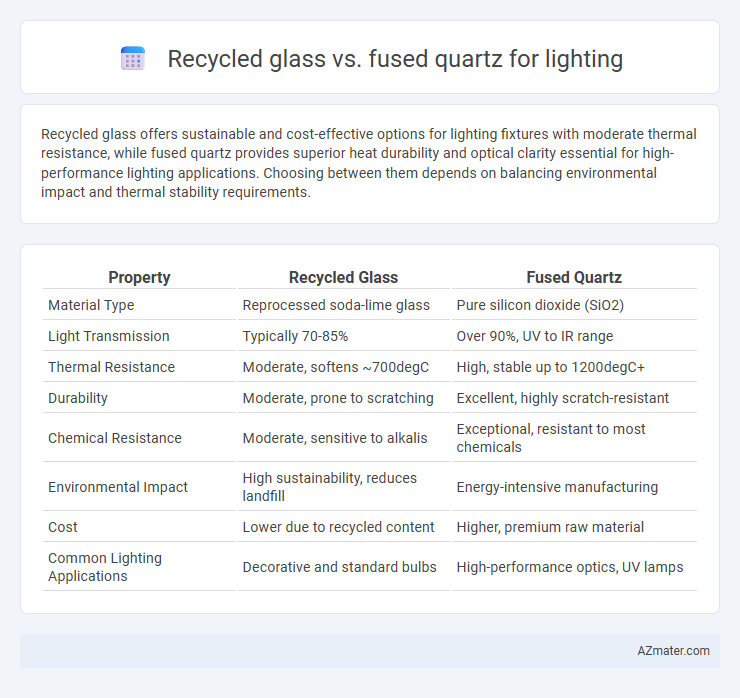Recycled glass offers sustainable and cost-effective options for lighting fixtures with moderate thermal resistance, while fused quartz provides superior heat durability and optical clarity essential for high-performance lighting applications. Choosing between them depends on balancing environmental impact and thermal stability requirements.
Table of Comparison
| Property | Recycled Glass | Fused Quartz |
|---|---|---|
| Material Type | Reprocessed soda-lime glass | Pure silicon dioxide (SiO2) |
| Light Transmission | Typically 70-85% | Over 90%, UV to IR range |
| Thermal Resistance | Moderate, softens ~700degC | High, stable up to 1200degC+ |
| Durability | Moderate, prone to scratching | Excellent, highly scratch-resistant |
| Chemical Resistance | Moderate, sensitive to alkalis | Exceptional, resistant to most chemicals |
| Environmental Impact | High sustainability, reduces landfill | Energy-intensive manufacturing |
| Cost | Lower due to recycled content | Higher, premium raw material |
| Common Lighting Applications | Decorative and standard bulbs | High-performance optics, UV lamps |
Introduction: Recycled Glass vs Fused Quartz for Lighting
Recycled glass offers an eco-friendly and cost-effective option for lighting applications, providing good thermal resistance and optical clarity. Fused quartz, known for its superior heat tolerance and high UV transmission, is ideal for high-performance lighting requiring durability and precision. Comparing recycled glass and fused quartz highlights the balance between sustainability and advanced material properties in lighting design.
Material Composition and Source
Recycled glass for lighting primarily consists of silica (SiO2) combined with soda ash, lime, and various metal oxides derived from post-consumer or industrial glass waste, enabling sustainable reuse of raw materials. Fused quartz is a highly pure form of silicon dioxide, sourced from melting high-purity quartz sand at extremely high temperatures, resulting in exceptional thermal and optical properties. The recycled glass benefits sustainability through utilizing waste streams, while fused quartz offers superior chemical and thermal stability due to its near 100% SiO2 composition from natural quartz.
Environmental Impact and Sustainability
Recycled glass lighting materials significantly lower environmental impact by reducing landfill waste and minimizing energy consumption during production compared to virgin glass. Fused quartz offers exceptional durability and thermal resistance, extending product lifespan and reducing replacement frequency, which contributes to sustainability. Choosing recycled glass supports circular economy principles, while fused quartz's long-term performance favors resource efficiency in high-performance lighting applications.
Light Transmission and Optical Clarity
Recycled glass offers moderate light transmission with some impurities impacting optical clarity, making it suitable for decorative lighting applications where cost and sustainability are prioritized. Fused quartz provides exceptional light transmission of over 90% across a broad spectrum and superior optical clarity due to its high purity and low impurity content, ideal for high-performance lighting systems and precision optical components. The choice between recycled glass and fused quartz hinges on balancing optical performance requirements with environmental and budget considerations.
Heat Resistance and Thermal Stability
Recycled glass exhibits moderate heat resistance with a melting point around 1400degC, making it suitable for many lighting applications but less stable under extreme thermal conditions. Fused quartz outperforms recycled glass by offering superior thermal stability and an exceptionally high melting point near 1700degC, ensuring minimal expansion and deformation under intense heat. These properties make fused quartz the preferred material for high-performance lighting systems requiring durability and consistent optical clarity at elevated temperatures.
Durability and Longevity in Lighting Applications
Recycled glass offers moderate durability with potential for surface scratches and lower resistance to thermal shock compared to fused quartz in lighting applications. Fused quartz exhibits exceptional longevity due to its high thermal stability, resistance to UV radiation, and minimal expansion under heat, making it ideal for high-intensity and precision lighting. The superior durability of fused quartz ensures consistent performance and reduced maintenance over extended operational lifespans in demanding lighting environments.
Design Flexibility and Aesthetic Qualities
Recycled glass offers exceptional design flexibility due to its ability to be molded into various shapes and infused with colors, creating unique, eco-friendly lighting fixtures with a distinctive textured appearance. Fused quartz, known for its high optical clarity and minimal impurities, provides sleek, modern aesthetic qualities ideal for clean, minimalist lighting designs that emphasize transparency and light diffusion. Both materials support innovative lighting concepts, but recycled glass emphasizes artistic customization while fused quartz excels in precision and purity of light transmission.
Cost Considerations and Market Availability
Recycled glass offers a cost-effective solution for lighting applications due to lower raw material costs and widespread availability in the recycled materials market, making it a popular choice for eco-conscious manufacturers. Fused quartz, while significantly more expensive owing to its high-purity silica content and complex manufacturing process, provides superior thermal stability and optical clarity essential for high-performance lighting systems. Market availability of recycled glass is extensive and growing with recycling initiatives, whereas fused quartz remains limited to specialized suppliers, impacting its accessibility and pricing for broader lighting industry use.
Common Uses in Modern Lighting Fixtures
Recycled glass is commonly used in modern lighting fixtures for decorative elements such as pendant lights, lampshades, and mosaic inlays due to its eco-friendly nature and ability to diffuse light softly. Fused quartz, known for its high thermal resistance and durability, is preferred in industrial and high-performance lighting applications, including UV lamps, LED components, and optical fibers. The choice between recycled glass and fused quartz depends on the balance between aesthetic appeal and functional requirements like heat tolerance and light transmission efficiency.
Pros and Cons: Choosing the Right Material for Lighting
Recycled glass offers sustainable benefits with lower environmental impact and cost efficiency, making it ideal for eco-friendly lighting designs. However, it may have lower thermal stability and optical clarity compared to fused quartz, which excels in high-temperature resistance and superior light transmission, ensuring durability in demanding lighting applications. The choice depends on balancing sustainability goals with performance requirements such as heat tolerance and light quality.

Infographic: Recycled glass vs Fused quartz for Lighting
 azmater.com
azmater.com